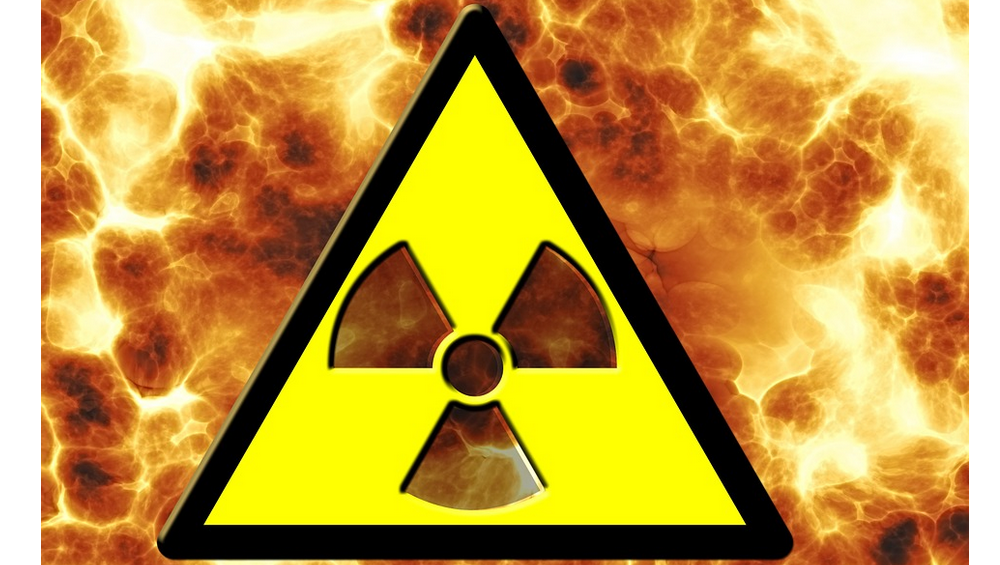 By Aaron Kesel
By Aaron Kesel
Scientists dispute that the first of two explosions reported by eyewitnesses was a nuclear explosion and not steam, as is widely believed. Instead, researchers have now announced that they believe that the first explosive event noted by eyewitnesses was debris ejected to an elevation of almost 2 miles by a series of nuclear explosions within Chernobyl’s reactor. A few seconds later, experts say, a steam explosion further ruptured the reactor and sent even more debris flying into the atmosphere at lower altitudes, according to an article in the journal Nuclear Technology.
“We realized that we, based on real measurements and observations, could explain details in the Chernobyl accident scenario and the nature of the two major explosions that occurred during a few seconds that unfortunate night more than 31 years ago,” Lars-Erik De Geer, the report’s lead author said in an email to Fox News.
The 1986 disaster at the Chernobyl nuclear plant in Ukraine left the one of the wort widespread environmental disasters in history. Thirty workers died from a combination of the explosion or radiation sickness within several months. The accident exposed millions of people in the country to highly dangerous levels of radiation. It ultimately led to the permanent evacuation of hundreds of towns and villages in Ukraine and Belarus.
The report cites xenon isotopes that were detected by the VG Khlopin Radium Institute in Leningrad four days after the accident.
According to the researchers from the Swedish Defense Research Agency, the Swedish Meteorological and Hydrological Institute and Stockholm University, as a result of recent nuclear fission, the isotopes were likely caused by a recent nuclear explosion. This is in contrast to the main Chernobyl debris that contained equilibrium xenon isotopes from the reactor’s rupture and drifted toward Scandinavia.
The disaster spotlighted safety problems for nuclear reactors and government secrecy in the former Soviet Union. The explosion on April 26, 1986, was not reported by Soviet authorities for two days and as only reported after the radiation had spread to Europe.
De Geer told Fox News that the Chernobyl disaster could only happen in Soviet-era reactors built using a design known as Reaktor Bolshoy Moshchnosti Kanalnyy (RBMK,) or “High Power Channel-Type Reactor.” There are 11 RBMK Reactors operating in Russia, according to The World Nuclear Association.
“Our new theory deepens the understanding of the severe effects that can be the result of some original design faults in such reactors,” De Geer added. “Much has been corrected in remaining RBMK reactors, but a better understanding of what really happened in 1986 must, of course, be of great value for overseeing and possibly improving the design also in the future.”
The final death toll and the number of people affected by the long-term effects of radiation from Chernobyl is unknown, but estimates range between 9,000 to a possible 90,000 by the environmental group Greenpeace.
The frightening environmental fallout of Chernobyl is still being felt. A wild boar with more than 10 times the safe limit of radiation, for example, was recently killed by hunters hundreds of miles away in Sweden.
 This comes as Russia’s meteorological service recently confirmed “extremely high” concentrations of the radioactive isotope ruthenium-106 in parts of the country in late September, following European reports about the contamination this month.
This comes as Russia’s meteorological service recently confirmed “extremely high” concentrations of the radioactive isotope ruthenium-106 in parts of the country in late September, following European reports about the contamination this month.
Despite this Russia has denied that it is the source of high radioactivity levels.
Greenpeace has called for an investigation into the matter after high levels of ruthenium-106, 986 times the norm were found in the atmosphere near the Urals site.
After reports of a ruthenium-106 leak from a plant in the southern Urals first appeared, Russia’s state-controlled Rosatom corporation said in a statement last month that it hadn’t come from its facilities.
“Rosatom categorically confirms there have been no unreported accidents or reportable events on any of its nuclear sites,” the company told The New York Times.
Meanwhile, the Institute for Radiological Protection and Nuclear Safety is reassuring the public in a report stating the release of the isotope ruthenium-106 posed no health or environmental risks to European countries, and that it wasn’t attributed to a nuclear reactor but was rather fingered as being a product from the disposing of radioactive material.
European countries were affected, with radiation levels measured between 100 and 300 terabecquerels (where one becquerel is the activity of a quantity of radioactive material in which one nucleus decays per second). By comparison, the 1986 Chernobyl nuclear disaster produced a total of about 5.2 million terabecquerels, and the 2011 Fukushima disaster churned out an estimated 900,000 terabecquerels, Gizmodo reported.
According to Phys.org, the highest concentration was registered at the station in Argayash, a village in the Chelyabinsk region in the southern Urals, which had “extremely high pollution” of Ru-106, exceeding natural background pollution by 986 times.
“Probes of radioactive aerosols from monitoring stations Argayash and Novogorny were found to contain radioisotope Ru-106” between September 25 and October 1, the Rosgidromet service said.
The service did not point to any specific source of the pollution, but the Argayash station is about 18.6 miles from the Mayak nuclear facility, which in 1957 was the site of one of the worst nuclear disasters in history.
Today, Mayak is a reprocessing site for used nuclear fuel. This would seem to corroborate the Nuclear Safety report in which the group said the source of the pollution was probably an accident somewhere between the Volga River and the Ural Mountains.
After denying a nuclear leak for several months, Russia later admitted that the nuclear leak was coming from Mayak, The Times reported.
The media is trying to downplay this as nothing significant without any health risks. However, this story is incomplete; officials have detected high levels of radiation since January not September and have flown U.S. “Constant Phoenix” radiation detection planes.
? “Constant Phoenix” now on final for RAF Mildenhall, UK ?? pic.twitter.com/9MAoZ6Kl1z
— Aircraft Spots (@AircraftSpots) February 17, 2017
In late February, trace amounts of radioactive Iodine-131 of unknown origin were detected over large areas in Europe suspected to be from the vicinity of the Arctic circle, according to a report by the Institute for Radiological Protection and Nuclear Safety.
Germany’s Federal Office for Radiation Protection (FORP) said that elevated levels of the isotope ruthenium-106 have been reported in Germany, Italy, Austria, Switzerland and France since Sept. 29. The highest concentration was found in Vienna, at 42 millibequerel per cubic meter. FORP raised the alarm initially after five weather service stations detected traces of the particle.
Best Selling Prepper and Survival Gear on Amazon (Ad)
According to the FORP, since only ruthenium-106 was detected, a nuclear power plant accident can be ruled out as the source. It is still unknown where the iodine-131 came from, but it should set a precedent since there are now two radiation leak events of two different isotopes where no one knows where they came from.
“Ruthenium is very rare and hence its presence may suggest that an event of some nature has occurred. That being said, the natural abundance is so low that even a factor of 900 up on natural levels is still very low,” medical physicist Malcolm Sperrin from Oxford University Hospitals in the UK explained.
Nonetheless, the IRSN concluded that if the accidental release of this much ruthenium–106 had occurred on French soil, there would have been immediate evacuations of the area up to a few miles around the origin point. So it’s still a significant event that should be treated with caution. Both isotopes do not occur naturally, but is unknown how they came to be released into the atmosphere.
The real significance is phasing out the use and need of nuclear energy and materials because there have been way too many concerns about leaks of hazardous material. Nuclear is a risk to both humans and our environment alike.
Aaron Kesel writes for Activist Post. Support us at Patreon. Follow us on Facebook, Twitter, Steemit, and BitChute. Ready for solutions? Subscribe to our premium newsletter Counter Markets.

The Russian Government did not officially report this accident for two days, because the Director of the Chernobyl site did not inform them of the severity of that accident! Get your goddamn facts straight!
Radiation is good for you…
get your vitamin,
Caesium-137
“Scientists dispute that the first of two explosions reported by eyewitnesses was a nuclear explosion and not steam,”
Wrong. They dispute that it was steam. The way the word “dispute” works is that “x disputes y” means “x claims that y is wrong”.
The death toll is in the millions and rising, no one should be eating food grown in Europe, and the accident is still on going just like Three Mile Island and the ongoing meltdown in Japan. Literally there are thousands of incidents every year at all the varying facilities all along the nuclear chain of activity from university reactors to the waste depositories sitting on those fault lines and along those rivers that supply your drinking water. Anyone living within 300 hundred miles of a commercial nuclear reactor is being dosed. I personally know of people who have been told by the gov and the utility that ran the Beaver Valley Nuclear Power Station that they should not eat from their gardens. This mess is proof that the military’s mindset of engagement includes the demise of all populations in order to possess and use their nuclear weapons of mass destruction. From the tech perspective the nuclear power plant is inefficient for making electricity which is the by-product of making the plutonium. This is a form of planned obsolescence and Geo-engineering; a good way to remove humans from the environment.
My guess, it was probably our very own Hanford site gassing off.